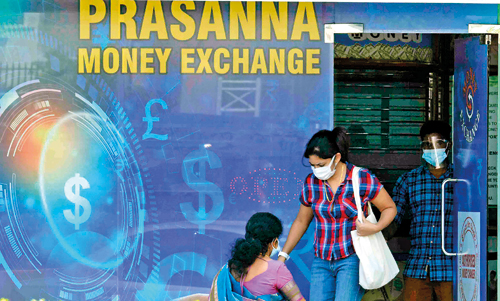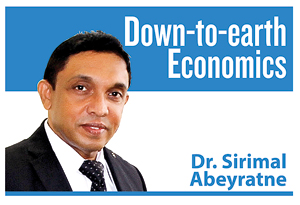Success of export-oriented economies
View(s):
File picture of a money exchange shop, patronised frequently due to the demand for dollars.
High-income OECD countries in the world had about 75 percent of the world exports in 1990. Today, about 30 years later, this export share has declined to little more than 50 percent. Looking at it from the other end, the world export share of developing countries was about 25 percent in 1990, and it has grown to nearly 50 percent by 2020.
During the same period of the past 30 years, world exports have grown more than “five times” from US$3.5 trillion to $18 trillion. This means that the developing countries have increased their exports exponentially much faster than the rich countries, from below $1 trillion in 1990 to over $8 trillion by 2020. The change was not a miracle, as it was made possible by a decisive shift in development policy from import substitution to export promotion.
Import substitution
vs export promotion
As import substitution in developing countries failed in assuring their development, they started moving to export-oriented policies – initially, a few countries in the 1970s, then many countries in the 1980s, and finally almost all the countries by the early 1990s.
Interestingly, Sri Lanka was one of the forerunners leading many others as early as 1977. But the initial export spurt it had, did not last more than two decades due to its own problems, while most of the late-comers started to run surpassing Sri Lanka. Some of us might have a question about “what are those own problems”. For the moment, I believe, a short answer would suffice: “We did not carry the reform agenda forward.”
The issue which we touch upon today is that what made it possible for “export-oriented” economies to grow fast. Last week, we focused on the question why import-substituting economies failed. We saw that import controls might help few businesses to prosper; they can have a monopoly market where there is no competition from imports so that they can exploit their customers with high price for low quality. But we cannot multiply it to national level converting “import controls” to a national policy because of the “fallacy of composition” problem.
As the countries started abandoning their import-substitution policies and embracing export-oriented policies, generally we saw their exports expanding and growth accelerating together with income and employment generation. As a result, they were able to generate foreign exchange earnings which resulted in a growing stock of foreign reserves and stable exchange rates as well as growing tax revenues to meet government expenditure. As the success of export-oriented economies became apparent, all of the developing countries started embracing export-oriented policies – some abruptly, some gradually, and some reluctantly.
Exports without opening
A shift into export-oriented policies required liberalisation or market policies, which were said to have resulted in an “open economy”. Why can’t we generate exports, without opening the economy? Again, it is a question related to the “fallacy of composition”. For a particular business, it may be a possibility, while there may be some businessmen who have made a fortune out of it. But if we try to multiply that business experience to national level by attempting to push exports within an import substitution framework, it is a waste of time and resources. Evidence in this respect is not scarce in the world.
 Faced with worsening foreign exchange shortages, many developing countries tried to push exports within their import substitution regimes, but without any success. In fact, Sri Lanka was one of these countries and tried pushing “non-traditional” exports since the 1960s. But it all became futile efforts, compared with the aggravating foreign exchange shortage.
Faced with worsening foreign exchange shortages, many developing countries tried to push exports within their import substitution regimes, but without any success. In fact, Sri Lanka was one of these countries and tried pushing “non-traditional” exports since the 1960s. But it all became futile efforts, compared with the aggravating foreign exchange shortage.
This type of strategies may work for someone who would benefit from import controls and to engage in exports too, but it does not mean that it works as a national policy. What is required in a national policy is to set up a “conducive policy environment” which would attract investment seeking global markets – not just the domestic market with few million people.
A conducive policy environment often requires liberalisation policies, because they all had been following “import controls” resulting in a policy bias against exports. This “anti-export bias” has to be eliminated by reducing tariffs, removing non-tariff barriers, and relaxing foreign exchange controls.
Further, export growth requires private investment; as domestic private investment is too small to make a big leap forward. The door has to be open for foreign direct investment (FDI). If FDI is not coming in, there must be “something” which keeps them away from the country; there is no need to elaborate that such bottlenecks should be removed too.
Opportunities
and challenges
Why do export-oriented policies work for developing countries? This was one of the important questions that has been answered in a vast body of trade literature which supported the decisive change in world development thinking since the 1970s. They included both theoretical and empirical studies carried out by various economists who worked in the area of international trade as well as numerous global research organisations.
In finding a simple answer to this question, you need to start with the “size” of the market, which is the global market in the case of export production compared with the local market in the case of import substitution production. The global market offers both opportunities and challenges, whereas the local market is limited by both. Opportunities provide unlimited space for expansion and for reaping the benefits of economies of scale; thus businesses grow on a global scale and become competitive.
As challenges, global markets also provide space to being exposed to competition in terms of both price and quality. As a result, there is a constant quest for technological advancement and productivity improvement because the businesses which do not carry these elements will naturally be ousted from
the race.
Focus on competition is not necessary in import substitution under import controls as such businesses continue to survive without improving either price or quality and even without an expansion. This means that export-oriented countries are “dynamic” in terms of their businesses as they continue to change and grow with new investment, technological upgrading and higher
productivity, while import substituting economies continue to remain stagnant.
Defensive strategy
As export-oriented policies started sweeping across developing countries, proponents of the older import substitution policies lost their ground. Given the politics of academia, accepting the reality is apparently a difficult choice; they started fighting with “defensive strategies” which have given birth to new turns in the trade debate.
One important aspect of the defensive strategy was the idea of “new export pessimism”. According to this argument, just a few countries can succeed with export promotion (as they referred to South Korea, Singapore, Taiwan and Hong Kong), but not everybody! This argument lost the ground because the expansion of world trade growing continuously and, its growth have been
even faster than the world
GDP growth.
Another side of the defensive strategy, supported by evidence picked up from countries like South Korea, was that it is the government that nurtured businesses behind import protection and then made them to be export industries. Of course, governments have picked up businesses to give them special favours; there are success cases as well as failures, while everybody likes to quote success stories but not the cases of failures. The most profound evidence is that it was the “overall” conducive policy environment which enable these countries to become developed, and not the individual cases of picking up here and there.
Is Sri Lanka an export-oriented economy? I am sure this is a debatable question to many; if it is a export-oriented economy, there cannot be a policy bias against exports. Sri Lanka’s track record in a comparative perspective is, anyway, a reflection of dismal export performance over the past 25 years! For the same reason, we have been caught up in the above debate and left in a limbo not knowing where to turn!
(The writer is a Professor of Economics at the University of Colombo and can be reached at
sirimal@econ.cmb.ac.lk and follow on Twitter @SirimalAshoka).


